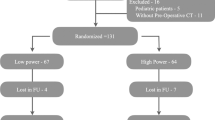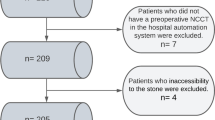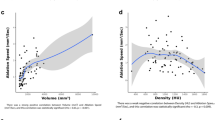Abstract
Retrograde Intra-Renal Surgery (RIRS) plays a primary role in renal stone treatment context. Energy, frequency and width of laser impulse can be modulated by surgeons to achieve better outcomes. In our study, patients with single renal stone sized 10–20 mm were retrospectively divided into two groups. Patients of Group 1 underwent RIRS with Low-Energy (LE) High-Frequency (HF) settings using Lumenis® 120-W high-power Ho:YAG laser. Patients of Group 2 (control) underwent RIRS using “standard” settings by means of Sphinx® Jr 30 W Ho:YAG system. Follow-up was conducted with a CT scan at 3 months after RIRS in both groups. Procedure success was defined as stone-free or presence of ≤ 4 mm fragments (Clinical Insignificant Residual Fragments—CIRF). A total number of 199 patients were included: 86 LE/HF RIRS (Group 1) vs 113 “conventional” RIRS (Group 2). Mean operative time was 56.6 (± 19.4) min in Group 1 vs 65.2 (± 25.2) min in Group 2 (p = 0.01). Mean hospitalization time was 2.5 ± 1.7 days for Group 1 vs 2.9 ± 3.2 days for Group 2 (p = 0.2). Peri-operative complications were counted: eight in Group 1 and 11 in Group 2 (p > 0.05). At 3-month control, stone-free rate was 69% (59/86 patients) in Group 1 vs 65% (73/113 patients) in Group 2 (p = 0.6). Success rate was 93% (80/86) in Group 1 in comparison to 82% (93/113) in Group 2 (p = 0.03). In conclusion, LE/HF RIRS seems to be a feasible and effective technique with a reduction of operative time and optimal results in terms of “stone-free” and “success” rates. Further studies are needed to ensure the validity of our results and to give evidence-based statements.
Similar content being viewed by others
Availability of data and material
Available if necessary.
References
Türk C, Skolarikos A, Neisius A, Petrik A, Seitz C, Thomas K, et al (2019) EAU Guidelines. Edn. presented at the EAU Annual Congress Barcelona 2019. ISBN 978-94-92671-04-2
Fiori C, Autorino R (2018) Flexible ureteroscopy for kidney stones in the third millennium: lights and shadows. Minerva Urol e Nefrol 70:543–545. https://doi.org/10.23736/S0393-2249.18.03354-4
Ulker V, Cakmak O, Yucel C et al (2019) The efficacy and safety of bilateral same-session ureteroscopy with holmium laser lithotripsy in the treatment of bilateral ureteral stones. Minerva Urol Nefrol 71(2):174–180
Ahmed I, Mostafa ME, Nader F, Serge C, Sero A (2018) Double-blinded prospective randomized clinical trial comparing regular and moses modes of holmium laser lithotripsy: Preliminary results. Eur Urol Suppl. https://doi.org/10.1016/S1569-9056(18)31815-3
Kronenberg P, Traxer O (2019) The laser of the future: reality and expectations about the new thulium fiber laser-a systematic review. Transl Androl Urol 8:S398-417. https://doi.org/10.21037/tau.2019.08.01
Keller EX, De Coninck V, Doizi S, Daudon M, Traxer O (2019) What is the exact definition of stone dust? An in vitro evaluation. Eur Urol Suppl 18:e484. https://doi.org/10.1016/s1569-9056(19)30363-x
Peng G, Song L, Xie D, Huang J, Zhong Y, Tan W et al (2018) Suctioning flexible ureteroscopic lithotripsy in the oblique supine lithotomy position and supine lithotomy position: a comparative retrospective study. Minerva Urol e Nefrol 70:612–616. https://doi.org/10.23736/S0393-2249.18.03144-2
Dindo D, Demartines N, Claiven PA (2004) Classification of surgical complications. Ann Surg 2:205–213
Bosio A, Dalmasso E, Alessandria E, Agosti S, Pizzuto G, Peretti D et al (2018) Retrograde intra-renal surgery under spinal anesthesia: the first large series. Minerva Urol e Nefrol 70:333–339. https://doi.org/10.23736/S0393-2249.18.02926-0
Çakici Ç, Özok HU et al (2019) Comparison of general anesthesia and combined spinal-epidural anesthesia for retrograde intrarenal surgery. Minerva Urol Nefrol 71(6):636–643
Carobbio F, Zamboni S et al (2020) Role of cultural analysis in patients with indwelling ureteral stent submitted to ureteroscopy for stones. Minerva Urol Nefrol 72(6):755–762
Aldoukhi AH, Roberts WW, Hall TL, Ghani KR (2017) Holmium laser lithotripsy in the new stone age: dust or bust? Front Surg 4:57. https://doi.org/10.3389/fsurg.2017.00057
Tracey J, Gagin G, Morhardt D, Hollingsworth J, Ghani KR (2018) Ureteroscopic high-frequency dusting utilizing a 120-W holmium laser. J Endourol 32:290–295. https://doi.org/10.1089/end.2017.0220
Pietropaolo A, Jones P et al (2019) Role of ‘dusting and pop-dusting’ using a high-powered (100 W) laser machine in the treatment of large stones (≥ 15 mm): prospective outcomes over 16 months. Urolithiasis 47:391–394
Kronenberg P, Somani B (2018) Advances in lasers for the treatment of stones—a systematic review. Curr Urol Rep 19:45
Funding
None.
Author information
Authors and Affiliations
Corresponding author
Ethics declarations
Conflict of interest
The authors declare that they have no conflict of interest.
Additional information
Publisher's Note
Springer Nature remains neutral with regard to jurisdictional claims in published maps and institutional affiliations.
Rights and permissions
About this article
Cite this article
Peretti, D., Dalmasso, E., Pecoraro, A. et al. Low-energy high-frequency Ho-YAG lithotripsy: is RIRS going forward? A case–control study. Urolithiasis 50, 79–85 (2022). https://doi.org/10.1007/s00240-021-01282-2
Received:
Accepted:
Published:
Issue Date:
DOI: https://doi.org/10.1007/s00240-021-01282-2




